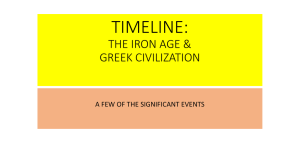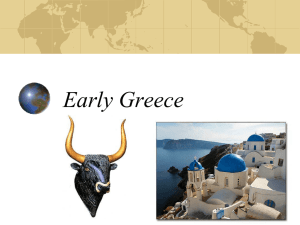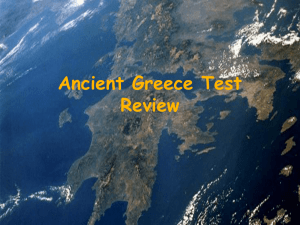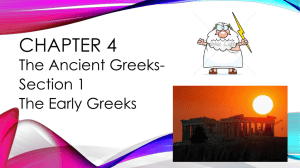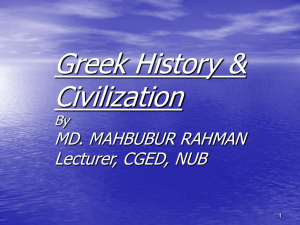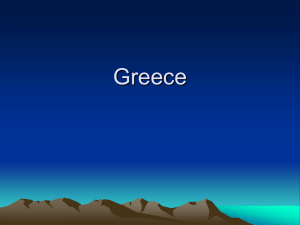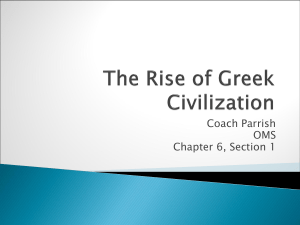Chapter 10 (Greek City States)
advertisement
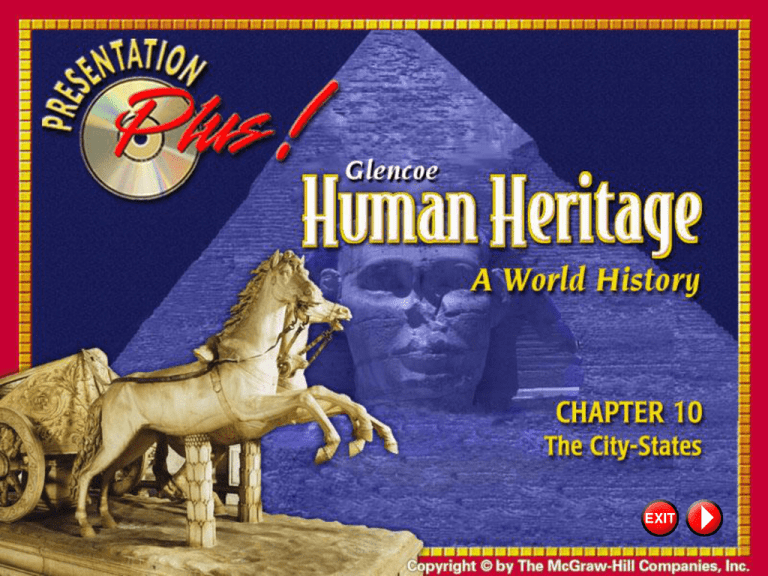
CHAPTER FOCUS SECTION 1 The Polis SECTION 2 Sparta SECTION 3 Athens SECTION 4 Decline of the City-States CHAPTER SUMMARY & STUDY GUIDE CHAPTER ASSESSMENT 2 Click a hyperlink to go to the corresponding section. Press the ESC key at any time to exit the presentation. Overview • Chapter 10 discusses Greek city-states, particularly Sparta and Athens. – Section 1 discusses the development of the Greek polis. – Section 2 summarizes the way of life in Sparta. – Section 3 describes the growth of democracy in Athens and its dominance in the Delian League. – Section 4 analyzes the decline of the Greek city-states. 3 Click the mouse button or press the Space Bar to display the information. Objectives After studying this chapter, you will be able to: • explain why the polis was the geographic and political center of Greek life. • describe what life was like in Sparta and Athens. • summarize how the Persian Wars affected Greece. • discuss how Athens controlled the other city-states. • explain why Athens and the other city-states declined. 4 Click the mouse button or press the Space Bar to display the information. Read to Discover • Why the polis was the geographic and political center of Greek life • What life was like in the city-states of Sparta and Athens • How the Persian Wars affected Greece • How Athens controlled other city-states • Why the Greek city-states declined 5 Click the mouse button or press the Space Bar to display the information. The Chapter Focus is on page 163 of your textbook. Terms to Learn • polis • acropolis • agora • aristocrats • oligarchy • constitution • mercenaries 6 People to Know • Solon • Cleisthenes • Darius • Xerxes • Pericles Places to Locate • Sparta • Athens • Ionia • Delos • Thebes Click the mouse button or press the Space Bar to display the information. Click the Speaker On button to listen to the words. Why It’s Important The geography of Greece–the mountains and the sea–separated communities from each other. Although these communities spoke the same language and shared many of the same customs, no single community had power over the others. Because of this, people developed a loyalty to the community in which they lived. These communities, known as city-states, became a feature of Greek civilization. Click the Speaker On button to replay audio. 7 The Polis • The polis, or city-state, was the geographic and political center of Greek life. • At first, each polis was made up of farming villages, fields, and orchards grouped around a fortified hill called an acropolis. • At the top of the acropolis stood the temple of the local god. • At the foot was the agora, an open area used as a marketplace. 9 Click the mouse button or press the Space Bar to display the information. Section 1 begins on page 163 of your textbook. The Polis (cont.) • By 700 B.C., this inner part of the polis had become a city. • Together with the villages and farmland around it, it formed a city-state. • The average city-state contained between 5,000 and 10,000 citizens. • For Greek citizens in ancient times, civic and personal honor were one and the same. • Two of the greatest Greek city-states were Sparta and Athens. 10 Click the mouse button or press the Space Bar to display the information. Section Assessment What areas generally made up each city-state? Farming villages, fields and orchards grouped around an acropolis, and an agora at the foot of the acropolis generally made up a city-state. 11 Click the mouse button or press the Space Bar to display the answer. Section Assessment (cont.) What rights and duties did Greek citizens have? rights–they could own property, hold public office, and speak for themselves in court duties–they were expected to take part in government and to defend their polis 12 Click the mouse button or press the Space Bar to display the answer. Section Assessment (cont.) Demonstrating Reasoned Judgment Which of the requirements for citizenship in early Greece do you think were fair and which were not? Explain. Answers will vary but could include references to discrimination by birth. 13 Click the mouse button or press the Space Bar to display the answer. Section Assessment (cont.) Draw a web like the one on page 164 of your textbook, and use it to show characteristics of most Greek city-states. Characteristics might include: centered around an acropolis; had own governments and laws; contained an average of 5,000–10,000 citizens; included an open-air market; only citizens could vote, own property, speak for themselves, or hold office 14 Click the mouse button or press the Space Bar to display the answer. Sparta • Sparta was in the south-central region of Greece, in an area known as the Peloponnesus. • By 500 B.C., it had become the greatest military power in Greece. • Though first ruled by a king, aristocrats, or nobles, took over the government. • Only aristocrats could be Spartan citizens. • All citizens over 20 years old were members of the Assembly, which passed laws and decided questions of war and peace. 16 Click the mouse button or press the Space Bar to display the information. Section 2 begins on page 164 of your textbook. Sparta (cont.) • Each year, the Assembly chose five managers, known as ephors, to take charge of public affairs and guide the education of young Spartans. • The Council of Elders helped the ephors. 17 Click the mouse button or press the Space Bar to display the information. Aristocrats, Helots, and Perioeci • The Spartans had little interest in farming. • The land was worked by helots, or enslaved people owned by the city-states. • The Spartans were not interested in business or trade either. • They left those to the perioeci, or merchants and artisans who lived in the villages. 18 Click the mouse button or press the Space Bar to display the information. Aristocrats, Helots, and Perioeci (cont.) • Helots and perioeci worked, while aristocrats trained for the army and war. • By about 750 B.C., there were 20 times as many helots and perioeci as there were aristocrats. 19 Click the mouse button or press the Space Bar to display the information. The Spartan Way of Life • The Spartans tried to become the strongest people in Greece. • When Spartan boys turned seven, they were sent to live in military camps. • Spartan men were expected to marry at 20 years of age. • Spartan women had more freedom than the women of other Greek city-states. • They mixed freely with men and enjoyed sports such as wrestling and racing. 20 Click the mouse button or press the Space Bar to display the information. The Spartan Way of Life (cont.) • The Spartans believed new ideas would weaken their way of life; therefore they tried to resist change. • From its beginnings until its defeat in 371 B.C., Sparta had only one goal–to be militarily strong. 21 Click the mouse button or press the Space Bar to display the information. Section Assessment How did the lifestyles of Spartan women differ from other Greek women? Spartan women had more freedom, mixed freely with their husband’s friends, enjoyed sports, and encouraged their men in battle. 22 Click the mouse button or press the Space Bar to display the answer. Section Assessment (cont.) Why did Sparta try to prevent change? They believed new ideas would weaken their way of life. 23 Click the mouse button or press the Space Bar to display the answer. Section Assessment (cont.) Making Comparisons How was Sparta similar to other Greek citystates? How was it different? similarities–made own government and laws, trained youth in sports differences–more freedom for women, spent energy on war, little interest in trade and the arts, depended on slave labor 24 Click the mouse button or press the Space Bar to display the answer. Section Assessment (cont.) Draw a chart like the one on page 167 of your textbook, and use it to weigh the pros and cons of living in Sparta. Answers will vary. 25 Click the mouse button or press the Space Bar to display the answer. Athens • Northeast of Sparta, the city-state of Athens had a very different philosophy about living than the Spartans. • Like all the other Greek city-states, Athens was first ruled by kings. • About 750 B.C., some Athenian nobles, merchants, and manufacturers took over the government. • They set up an oligarchy, or form of government in which a few people have the ruling power. 27 Click the mouse button or press the Space Bar to display the information. Section 3 begins on page 168 of your textbook. Athens (cont.) • Fights broke out between them and the farmers and artisans over land ownership. • The first attempt to change the government was made by Draco, a noble. • Draco, however, failed because his punishments were too harsh. • Then, in 594 B.C., a rich merchant named Solon was chosen to undertake the task. • Solon prepared a constitution, or a set of principles and rules for governing. 28 Click the mouse button or press the Space Bar to display the information. Athens (cont.) • This constitution broke the political power of the rich. • Under Solon, more Athenians began to take part in government, and trade increased. • About 560 B.C., the government was taken over by another Athenian named Peisistratus who was supported by the lower classes. • He stated that a person no longer had to own land to be a citizen. 29 Click the mouse button or press the Space Bar to display the information. A Democratic Constitution • When Peisistratus died, his sons took over as leaders of the Athenian government. • Not long after that, their government was overthrown by the Spartans. • In 508 B.C., the Spartans themselves were overthrown by a noble named Cleisthenes. • A year later, Cleisthenes put into effect the world’s first constitution that was democratic, or favoring the equality of all people. 30 Click the mouse button or press the Space Bar to display the information. A Democratic Constitution (cont.) • Cleisthenes opened the Assembly to all males over 20 years old. • The Council of Five Hundred handled the daily business of Athens. • The names of 500 citizens were drawn from a large pot. • Under Cleisthenes, citizens were required to educate their sons starting when they were seven years old. • When they turned 18 years old, Athenian males became citizens. 31 Click the mouse button or press the Space Bar to display the information. The Persian Wars • In 545 B.C., Persian conquered the Greek city-states in Asia Minor • About 20 years later, the city-states revolted. • Persians defeated the revolters. • In 490 B.C., Darius sent a fleet of 600 ships and a well-equipped army to Greece. 32 Click the mouse button or press the Space Bar to display the information. The Persian Wars (cont.) • The Persians fought Athens at the Battle of Marathon. • Greek soldiers launched a strategic attack and won the battle. • A runner set off for Athens with news of the victory. • Upon reaching Athens, he cried out Nike!, the Greek goddess of victory, and then died of exhaustion. 33 Click the mouse button or press the Space Bar to display the information. The Persian Wars (cont.) • Shortly after the Battle of Marathon, rich silver mines were found near Athens. • The Athenians spent their new wealth on triremes, or warships that had three levels of rowers on each side, one above the other. • In 480 B.C., Darius’s son Xerxes sent 250,000 soldiers across the sea and conquered northern Greece. • In order to stop the Persians from taking all of Greece, 20 Greek city-states banded together. 34 Click the mouse button or press the Space Bar to display the information. The Delian League and the Athenian Empire • The Persians had been driven from Greece, but they still ruled Asia Minor. • Because of this, the Athenians suggested that the Greek city-states form a defensive league, or protective group, called the Delian League. • Sparta was one of the few Greek city-states that did not join the League. • As time passed, though, Athens gained more and more power. 35 Click the mouse button or press the Space Bar to display the information. The Delian League and the Athenian Empire (cont.) • The more powerful Athens became, the more resentful other Greek city-states grew. • When the Athenians attacked one of Sparta’s allies, a group of city-states led by Sparta declared war on Athens. • The war, which was called the Peloponnesian War, lasted almost 30 years, ending in 404 B.C. when Athens surrendered to Sparta. 36 Click the mouse button or press the Space Bar to display the information. Decline of Athens (cont.) • Between the war and a plague that struck during the war, Athens also lost more than one quarter of its people. • Thousands of young Athenian men left home and became mercenaries, or hired soldiers, in the Persian army. • When the Spartans took control of Athens in 404 B.C., they set up an oligarchy and chose 30 Athenian aristocrats to rule there. • Not long after that, the Athenians successfully revolted and once more set up a democracy. 37 Click the mouse button or press the Space Bar to display the information. Section Assessment What political reforms did Cleisthenes introduce? He set up the first democratic constitution, opened the assembly to males over 20 and the council to all citizens. 39 Click the mouse button or press the Space Bar to display the answer. Section Assessment (cont.) What changes did Pericles bring to Athens? He rebuilt the palaces and temples on the acropolis, including the Parthenon; built the Long Walls; and encouraged philosophy and learning. 40 Click the mouse button or press the Space Bar to display the answer. Section Assessment (cont.) Understanding Cause and Effect What were some of the causes and effects of the Peloponnesian War? causes–Greek aid to Ionians, Persian expansion effects–buildup of Athenian navy, formation of Delian League 41 Click the mouse button or press the Space Bar to display the answer. Section Assessment (cont.) Draw a diagram like the one shown on page 175 of your textbook, and use it to show how the Delian League affected both Athens and other citystates. Athens–dominated Greece; gained wealth to beautify the acropolis other city-states–lost power; forced to use Athenian money, courts, and ships; grew resentful 42 Click the mouse button or press the Space Bar to display the answer. Decline of the City-States • After the Peloponnesian War, most Greeks began to lose their sense of community. • Bitterness developed between the upper and lower classes within each polis. • After the war, Sparta ruled Greece. • The Spartans were harsh rulers who angered the other Greeks. • As a result, in 371 B.C., a group of citystates led by Thebes overthrew Spartan rule. 43 Click the mouse button or press the Space Bar to display the information. Section 4 begins on page 175 of your textbook. Decline of the City-States (cont.) • The rule of Thebes, however, was no better than that of Sparta, weakening the city-states even more. • The Greeks were no longer strong enough or united enough to fight off invaders. • In 338 B.C., Philip II of Macedonia conquered Greece. 44 Click the mouse button or press the Space Bar to display the information. Section Assessment How did the Peloponnesian War help destroy the sense of community in most Greek city-states? The war lasted a long time and was costly; people were discouraged and they began to lose interest in what was good for their city-state. 45 Click the mouse button or press the Space Bar to display the answer. Section Assessment (cont.) What were some of the reasons for the decline of the Greek citystates? Bitterness developed between the upper and lower classes within each polis, the rule of Thebes weakened the city-states, and the Greeks could no longer fight off invaders. 46 Click the mouse button or press the Space Bar to display the answer. Section Assessment (cont.) Drawing Conclusions Why might the Greeks have become more interested in making money for themselves rather than for the city-state after the Peloponnesian War? Answers will vary but might include the idea that they were tired of being involved in war and decided to pay attention to themselves. 47 Click the mouse button or press the Space Bar to display the answer. Section Assessment (cont.) Draw a flow chart like the one on page 176 of your textbook, and use it to trace the decline of the Greek city-states after the Peloponnesian War. Sample responses: lost sense of community, increased interest in money-making, increased bitterness between upper and lower classes in each polis, harsh rule by Sparta, rebellion and rule by Thebes, lack of strength to resist invaders 48 Click the mouse button or press the Space Bar to display the answer. Chapter Summary & Study Guide • Around 700 B.C., city-states became the center of Greek life. • The two greatest city-states were Sparta and Athens. • Sparta spent most of its time training its citizens for war. • Spartan women had more freedom than women in other city-states. • Spartans believed new ideas would weaken their way of life, so they tried to prevent change. 50 Click the mouse button or press the Space Bar to display the information. Chapter Summary & Study Guide (cont.) • Between 750 and 507 B.C., Athens went through a series of reforms to broaden democracy. • In 507 B.C., Cleisthenes put into effect the first democratic constitution. • After several wars with Persia, Athens became Greece’s leading polis. • Sparta defeated Athens in the Peloponnesian War, which was fought between 431 and 404 B.C. 51 Click the mouse button or press the Space Bar to display the information. Chapter Summary & Study Guide (cont.) • The Peloponnesian War weakened the Greek city-states, leading to the conquest of Greece by Philip II of Macedonia in 338 B.C. 52 Understanding the Main Idea Why did Greek communities have little contact with one another? They had little contact with one another because they were separated by mountains and by the sea. 54 Click the mouse button or press the Space Bar to display the answer. Understanding the Main Idea What did the citizens of a polis consider most important? They considered the good of the polis to be most important. 55 Click the mouse button or press the Space Bar to display the answer. Understanding the Main Idea Why was it important for Spartan women to be physically fit? It was important to be physically fit so they would bear healthy male warriors. 56 Click the mouse button or press the Space Bar to display the answer. Understanding the Main Idea Why did Sparta remain a poor farming society? It remained a poor farming community because it spent its time and energy only on the art of war. 57 Click the mouse button or press the Space Bar to display the answer. Understanding the Main Idea Why was the Battle of Marathon important for the Greeks? The battle of Marathon was important because it gave the Greeks a great sense of confidence. 58 Click the mouse button or press the Space Bar to display the answer. Understanding the Main Idea How did Athenians use the Delian League to build an empire? Athens gained more power, controlled sailing and trade, and interfered in the politics of other city-states. 59 Click the mouse button or press the Space Bar to display the answer. Critical Thinking Do you think that the Spartan emphasis on military training benefited Sparta? Why or why not? Answers will vary. 60 Click the mouse button or press the Space Bar to display the answer. Critical Thinking What method of choosing members of the Athenian Council of Five Hundred would you have suggested? Explain your answer. Answers will vary. A blind drawing might have been more fair but less qualitative than an election. 61 Click the mouse button or press the Space Bar to display the answer. Critical Thinking Why do you think some people in Athens might have objected to the title of “first citizen” for Pericles? Explain your answer. Answers will vary. 62 Click the mouse button or press the Space Bar to display the answer. Critical Thinking What may happen to a community as a result of a long war? Why? Answers will vary. Possible results could include that people may become discouraged, fight among themselves, and lose their sense of community. 63 Click the mouse button or press the Space Bar to display the answer. Geography in History Place Note the location of the Greek citystates on the map on page 173. Why do you think these city-states developed in the places that they did, and what geographic features might have affected this development? Write a paragraph explaining the relationship between a city’s location and the surrounding geographic features. Answers may vary. Possible features could include references to good farming land, optimum location for trade and/or sea access, the safety of highlands or islands, and heritage. 64 Click the mouse button or press the Space Bar to display the answer. What would Cleisthenes say about a city-state ruled by one woman who served for life, a council elected by voting, no organized army, and public schools for all citizens? 65 Explore online information about the topics introduced in this chapter. Click on the Connect button to launch your browser and go to the Human Heritage: A World History Web site. At this site, you will find interactive activities, current events information, and Web sites correlated with the chapters and units in the textbook. When you finish exploring, exit the browser program to return to this presentation. If you experience difficulty connecting to the Web site, manually launch your Web browser and go to http://www.humanheritage.glencoe.com 67 700 B.C. 507 B.C. Greek citystates emerge Sparta adopts constitution 594 B.C. Athens expands citizenship Continued on next slide. 68 Click the mouse button or press the Space Bar to display the information. 338 B.C. 490 B.C. Philip II conquers Greece Persian Wars begin 404 B.C. Sparta wins Peloponnesian War 69 Click the mouse button or press the Space Bar to display the information. Pericles c. 495 B.C.-429 B.C. Athenian General As leader of Athens, Pericles turned the city-state into a center of learning. His influence was so great that historians call the period of his power the “Age of Pericles.” 70 The Marathon The runner Pheidippides carried the news of the victory at Marathon back to Athens, about 26 miles away. He delivered his message and fell dead of exhaustion. Today, a marathon is a footrace of 26 miles, 385 yards, or the term may describe any longdistance race. 71 Recognizing Bias • Cats make better pets than dogs. • If you say this–without ever having owned a dog–then you are stating a bias. • A bias is a prejudice. • It can prevent one from looking at a situation in a reasonable or truthful way. • Most people have feelings and ideas that affect their point of view. Continued on next slide. 72 Click the mouse button or press the Space Bar to display the information. Recognizing Bias • This viewpoint, or bias, influences the way they interpret events. • For this reason, an idea that is stated as a fact may really be only an opinion. • Recognizing bias will help you judge the accuracy of what you read. Continued on next slide. 73 Click the mouse button or press the Space Bar to display the information. Recognizing Bias To recognize bias, follow these steps: • Identify the author of the statement and examine his or her views and possible reasons for writing the material. • Look for language that reflects an emotion or opinion–words such as all, never, best, worst, might, or should. Continued on next slide. 74 Click the mouse button or press the Space Bar to display the information. Recognizing Bias • Examine the writing for imbalances–leaning only to one viewpoint and failing to provide equal coverage of other possible viewpoints. • Identify statements of fact. Factual statements usually answer the Who? What? Where? and When? questions. • Determine how the author’s bias is reflected in the work. Continued on next slide. 75 Click the mouse button or press the Space Bar to display the information. Recognizing Bias Read the excerpt on page 170 of your textbook in which a supporter of oligarchy–government by the few–evaluates how Athens dealt with members of the Delian League. Then answer the questions that follow. Continued on next slide. 76 Recognizing Bias Is the writer expressing a proAthens or anti-Athens bias? The writer is expressing an anti-Athens bias. Continued on next slide. 77 Click the mouse button or press the Space Bar to display the answer. Recognizing Bias What prejudice does the writer hold toward the lower classes? The author does not think they should be promoted to places of honor. Continued on next slide. 78 Click the mouse button or press the Space Bar to display the answer. Recognizing Bias What bias does the writer have toward the system of justice in Athens? The author resents being tried by the people. Continued on next slide. 79 Click the mouse button or press the Space Bar to display the answer. Recognizing Bias What bias does the writer hold toward democracy? The writer dislikes democracy and believes the “better sort of people” should rule. 80 Click the mouse button or press the Space Bar to display the answer. Reading Physical Maps • Physical maps are used to show something about the surface of Earth. • The colors used on physical maps may show the rainfall of a certain area. • They may also be used to show an area’s temperatures or elevations. • In the physical map on page 165 of your textbook, the colors indicate elevation. Continued on next slide. 81 Click the mouse button or press the Space Bar to display the information. Reading Physical Maps • Colors ranging from green to brown are used. • The meaning of each color is explained in the legend. • Look at the map “Elevation of Ancient Greece” shown on page 165. • The legend days that light brown means above 5,000 feet, or above 1,500 meters. Continued on next slide. 82 Click the mouse button or press the Space Bar to display the information. Reading Physical Maps • This means that any area on the map that is shaded light brown is at least 5,000 feet, or 1,500 meters, above sea level. • Remember that having an elevation of above 5,000 feet does not necessarily mean that an area is covered with mountains. • The area may actually be a plateau. Continued on next slide. 83 Click the mouse button or press the Space Bar to display the information. Reading Physical Maps Study the elevation map on page 165 of your textbook showing the elevation of ancient Greece. Then answer the questions that follow. Continued on next slide. 84 Reading Physical Maps What color shows an elevation of 1,000 to 2,000 feet, or 300 to 600 meters? yellow Continued on next slide. 85 Click the mouse button or press the Space Bar to display the answer. Reading Physical Maps What elevation is shown by the color dark green? Dark green shows 0 to 500 feet. Continued on next slide. 86 Click the mouse button or press the Space Bar to display the answer. Reading Physical Maps What generalization can you make about the elevation of ancient Greece? It has steep mountains and small, narrow plains. 87 Click the mouse button or press the Space Bar to display the answer. End of Custom Shows WARNING! Do Not Remove This slide is intentionally blank and is set to auto-advance to end custom shows and return to the main presentation.
